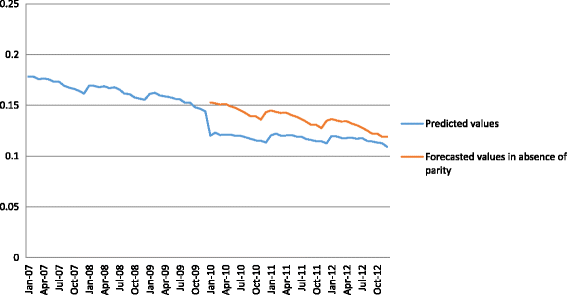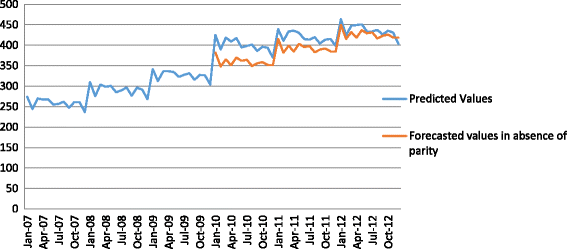Was federal parity associated with changes in Out-of-network mental health care use and spending?
- PMID: 28464814
- PMCID: PMC5414372
- DOI: 10.1186/s12913-017-2261-9
Was federal parity associated with changes in Out-of-network mental health care use and spending?
Abstract
Background: The goal of the Paul Wellstone and Pete Domenici Mental Health Parity and Addiction Equity Act is to eliminate differences in insurance coverage between behavioral health and general medical care. The law requires out-of-network mental health benefits be equivalent to out-of-network medical/surgical benefits. Insurers were concerned this provision would lead to unsustainable increases in out-of-network related expenditures. We examined whether federal parity implementation was associated with significant increases in out-of-network mental health care use and spending.
Methods: We conducted an interrupted time series analysis using health insurance claims from self-insured employers (2007-2012). We examined changes in the probability of using out-of-network mental health services and, conditional on out-of-network mental health service use, changes in the number of outpatient out-of-network mental health visits and total out-of-network mental health spending associated with the implementation of federal parity in 2010.
Results: From 2007 to 2012, the proportion of individuals receiving any out-of-network mental health services each month declined dramatically from 18 to 12%, with a one-time drop of 3 percentage points at parity implementation (p < .01). Among out-of-network mental health service users, there was an increase in the number of visits per month (.12 visits; p < .01) and total spending per month ($49; p < .01) at parity implementation. Although there was a one-time increase in spending at parity implementation, this increase was accompanied by an attenuation of a trend toward increased spending growth, such that spending was back to original predictions by the end of our study period.
Conclusions: Despite concerns expressed by the health insurance industry when federal parity was enacted, out-of-network mental health spending did not substantially increase after parity implementation. In addition, use of out-of-network mental health services appears to have contracted rather than expanded, suggesting insurers may have implemented other policies to curb out-of-network use, such as increasing access to in-network providers.
Figures


Similar articles
-
Federal parity law associated with increased probability of using out-of-network substance use disorder treatment services.Health Aff (Millwood). 2015 Aug;34(8):1331-9. doi: 10.1377/hlthaff.2014.1384. Health Aff (Millwood). 2015. PMID: 26240247 Free PMC article.
-
The effects of federal parity on substance use disorder treatment.Am J Manag Care. 2014;20(1):76-82. Am J Manag Care. 2014. PMID: 24512166 Free PMC article.
-
The Mental Health Parity and Addiction Equity Act evaluation study: Impact on specialty behavioral healthcare utilization and spending among enrollees with substance use disorders.J Subst Abuse Treat. 2017 Sep;80:67-78. doi: 10.1016/j.jsat.2017.06.006. Epub 2017 Jun 26. J Subst Abuse Treat. 2017. PMID: 28755776 Free PMC article.
-
What Does Mental Health Parity Really Mean for the Care of People with Serious Mental Illness?Psychiatr Clin North Am. 2016 Jun;39(2):331-42. doi: 10.1016/j.psc.2016.01.010. Epub 2016 Mar 8. Psychiatr Clin North Am. 2016. PMID: 27216906 Review.
-
Targeted Reforms in Health Care Financing to Improve the Care of Adolescents and Young Adults.Pediatrics. 2018 Dec;142(6):e20182998. doi: 10.1542/peds.2018-2998. Pediatrics. 2018. PMID: 30455343 Review.
Cited by
-
Prices And Cost Sharing For Psychotherapy In Network Versus Out Of Network In The United States.Health Aff (Millwood). 2020 Jul;39(7):1210-1218. doi: 10.1377/hlthaff.2019.01468. Health Aff (Millwood). 2020. PMID: 32634359 Free PMC article.
-
Changes in Medicaid Acceptance by Substance Abuse Treatment Facilities After Implementation of Federal Parity.Med Care. 2020 Feb;58(2):101-107. doi: 10.1097/MLR.0000000000001242. Med Care. 2020. PMID: 31688556 Free PMC article.
-
Factors Affecting State-Level Enforcement of the Federal Mental Health Parity and Addiction Equity Act: A Cross-Case Analysis of Four States.J Health Polit Policy Law. 2023 Feb 1;48(1):1-34. doi: 10.1215/03616878-10171062. J Health Polit Policy Law. 2023. PMID: 36112956 Free PMC article.
-
Federal parity law associated with increased probability of using out-of-network substance use disorder treatment services.Health Aff (Millwood). 2015 Aug;34(8):1331-9. doi: 10.1377/hlthaff.2014.1384. Health Aff (Millwood). 2015. PMID: 26240247 Free PMC article.
-
Association of Federal Mental Health Parity Legislation With Health Care Use and Spending Among High Utilizers of Services.Med Care. 2019 Apr;57(4):245-255. doi: 10.1097/MLR.0000000000001076. Med Care. 2019. PMID: 30807450 Free PMC article.
References
-
- Centers for Medicare and Medicaid Services Interim final rules under the Paul Wellstone and Pete Domenici mental health parity and addiction equity Act of 2008. Interim final rules with request for comments. Fed Regist. 2010;75(21):5409. - PubMed
-
- Kyanko KA, Busch SH. The out-of-network benefit: problems and policy solutions. Inquiry. 2013;49:352–61. - PubMed
-
- America’s Health Insurance Plans (AHIP) The value of provider networks and the role of out-of-network charges in rising health care costs: a survey of charges billed by out-of-network physicians. Washington, D.C: AHIP; 2009.
MeSH terms
Grants and funding
LinkOut - more resources
Full Text Sources
Other Literature Sources
Medical

